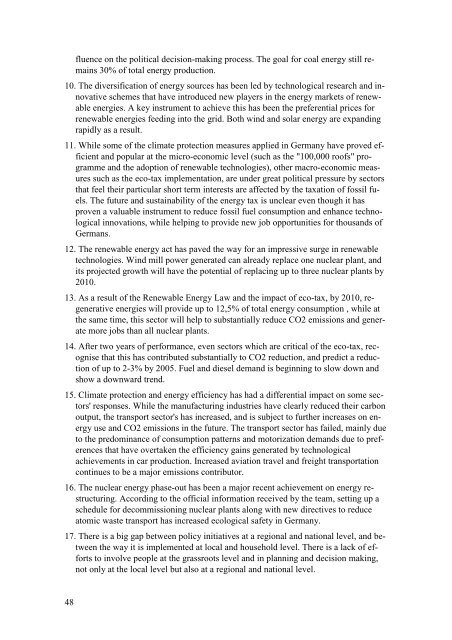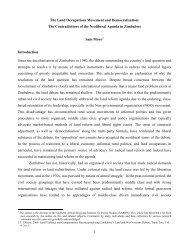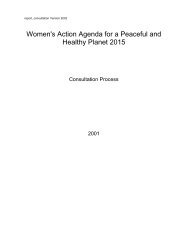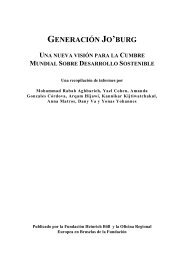Sustainable Germany: A View from the South; July 2002 -- pdf
Sustainable Germany: A View from the South; July 2002 -- pdf
Sustainable Germany: A View from the South; July 2002 -- pdf
Create successful ePaper yourself
Turn your PDF publications into a flip-book with our unique Google optimized e-Paper software.
fluence on <strong>the</strong> political decision-making process. The goal for coal energy still remains<br />
30% of total energy production.<br />
10. The diversification of energy sources has been led by technological research and innovative<br />
schemes that have introduced new players in <strong>the</strong> energy markets of renewable<br />
energies. A key instrument to achieve this has been <strong>the</strong> preferential prices for<br />
renewable energies feeding into <strong>the</strong> grid. Both wind and solar energy are expanding<br />
rapidly as a result.<br />
11. While some of <strong>the</strong> climate protection measures applied in <strong>Germany</strong> have proved efficient<br />
and popular at <strong>the</strong> micro-economic level (such as <strong>the</strong> "100,000 roofs" programme<br />
and <strong>the</strong> adoption of renewable technologies), o<strong>the</strong>r macro-economic measures<br />
such as <strong>the</strong> eco-tax implementation, are under great political pressure by sectors<br />
that feel <strong>the</strong>ir particular short term interests are affected by <strong>the</strong> taxation of fossil fuels.<br />
The future and sustainability of <strong>the</strong> energy tax is unclear even though it has<br />
proven a valuable instrument to reduce fossil fuel consumption and enhance technological<br />
innovations, while helping to provide new job opportunities for thousands of<br />
Germans.<br />
12. The renewable energy act has paved <strong>the</strong> way for an impressive surge in renewable<br />
technologies. Wind mill power generated can already replace one nuclear plant, and<br />
its projected growth will have <strong>the</strong> potential of replacing up to three nuclear plants by<br />
2010.<br />
13. As a result of <strong>the</strong> Renewable Energy Law and <strong>the</strong> impact of eco-tax, by 2010, regenerative<br />
energies will provide up to 12,5% of total energy consumption , while at<br />
<strong>the</strong> same time, this sector will help to substantially reduce CO2 emissions and generate<br />
more jobs than all nuclear plants.<br />
14. After two years of performance, even sectors which are critical of <strong>the</strong> eco-tax, recognise<br />
that this has contributed substantially to CO2 reduction, and predict a reduction<br />
of up to 2-3% by 2005. Fuel and diesel demand is beginning to slow down and<br />
show a downward trend.<br />
15. Climate protection and energy efficiency has had a differential impact on some sectors'<br />
responses. While <strong>the</strong> manufacturing industries have clearly reduced <strong>the</strong>ir carbon<br />
output, <strong>the</strong> transport sector's has increased, and is subject to fur<strong>the</strong>r increases on energy<br />
use and CO2 emissions in <strong>the</strong> future. The transport sector has failed, mainly due<br />
to <strong>the</strong> predominance of consumption patterns and motorization demands due to preferences<br />
that have overtaken <strong>the</strong> efficiency gains generated by technological<br />
achievements in car production. Increased aviation travel and freight transportation<br />
continues to be a major emissions contributor.<br />
16. The nuclear energy phase-out has been a major recent achievement on energy restructuring.<br />
According to <strong>the</strong> official information received by <strong>the</strong> team, setting up a<br />
schedule for decommissioning nuclear plants along with new directives to reduce<br />
atomic waste transport has increased ecological safety in <strong>Germany</strong>.<br />
17. There is a big gap between policy initiatives at a regional and national level, and between<br />
<strong>the</strong> way it is implemented at local and household level. There is a lack of efforts<br />
to involve people at <strong>the</strong> grassroots level and in planning and decision making,<br />
not only at <strong>the</strong> local level but also at a regional and national level.<br />
48







